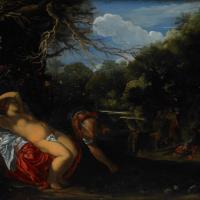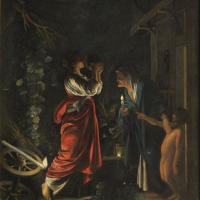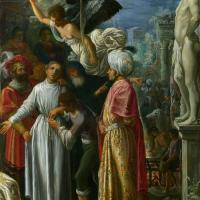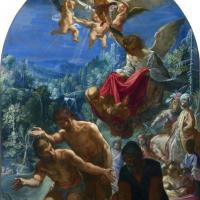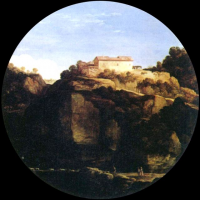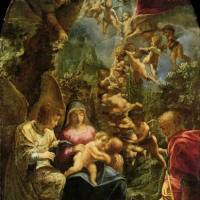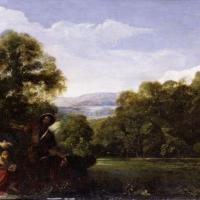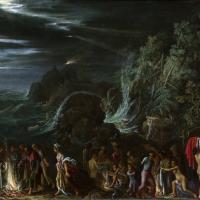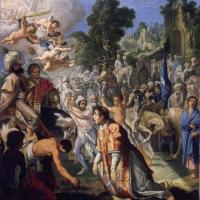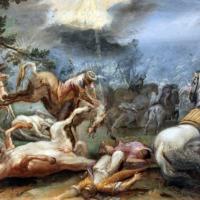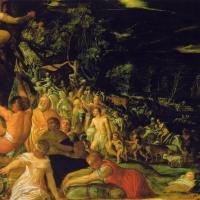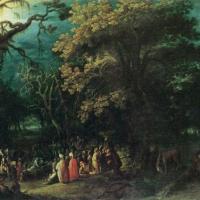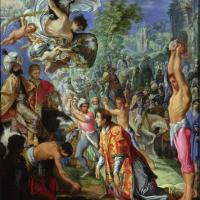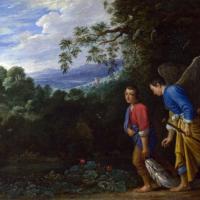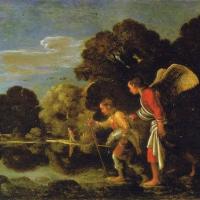Adam Elsheimer
Apollo And Coronis
$480.00
Ceres At Hecuba's Home
$540.00
Die Taufe Christi
$540.00
Haus Auf Dem Berge, Tondo
$510.00
St. Paulus Auf Malta
$480.00
The Conversion Of St. Paul
$480.00
The Great Flood
$540.00
The Stoning of Saint Stephen
$540.00
Tobias Und Der Engel
$480.00
Adam Elsheimer
Adam Elsheimer (1578-1610)
Adam Elsheimer (18 March 1578 – 11 December 1610) was a German artist working in Rome who died at only thirty-two, but was very influential in the early 17th century in the field of Baroque paintings. His relatively few paintings were small scale, nearly all painted on copper plates, of the type often known as cabinet paintings. They include a variety of light effects, and an innovative treatment of landscape. He was an influence on many other artists, including Rembrandt and Peter Paul Rubens.
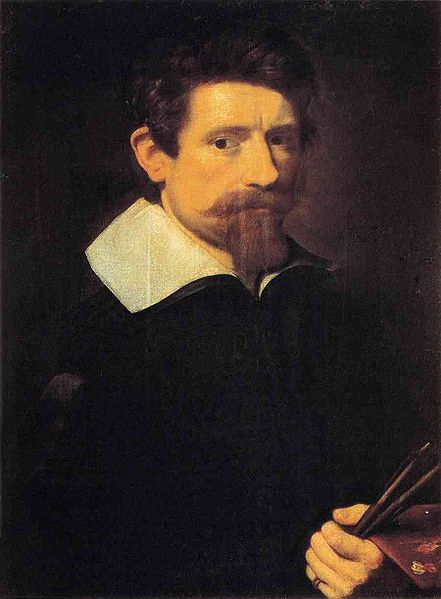
His perfectionism, and an apparent tendency to depression, resulted in a small total output, despite the small size of all his pictures. In all about forty paintings are now generally agreed to be by him (see Kressmann below). He made a few etchings, not very successfully. However, his work was highly regarded by other artists and a few important collectors for its quality. He had a clear and direct influence on other Northern artists who were in Rome such as Paul Bril, Jan Pynas, Leonaert Bramer and Pieter Lastman, later Rembrandt's master, who was probably in Rome by 1605. Rembrandt's first dated work is a Stoning of St Stephen which appears to be a response to Elsheimer's painting of the subject, now in Edinburgh. Some works by Italian artists, such as the six pictures from Ovid by Carlo Saraceni now in the Museo di Capodimonte, Naples, also show Elsheimer's clear influence. Rubens, who owned at least four of his works, knew Elsheimer in Rome, and praised him highly in a letter after his death.
In a wider sense, he was influential in three respects. Firstly his night scenes were highly original. His lighting effects in general were very subtle, and very different from those of Caravaggio. He often uses as many as five different sources of light, and graduates the light relatively gently, with the less well-lit parts of the composition often containing important parts of it.
Secondly, his combination of poetic landscape with large foreground figures gives the landscape a prominence that had rarely been seen since the Early Renaissance. His landscapes do not always feature an extensive view; often the lushness of the vegetation closes it off. They are more realistic, but no less poetic, than those of Bril or Jan Brueghel, and play a part in the formation of those of Poussin and Claude. His treatment of large figures with a landscape backdrop looks forward, through Rubens and van Dyck, to the English portrait in the eighteenth century. Soon after his death he became very popular with English collectors, notably King Charles I of England, the Earl of Arundel, and the George Villiers, 1st Duke of Buckingham, and over half his paintings have been in English collections at some time (nearly one third are still in the UK).
Thirdly, his integration of Italian styles with the German tradition he was trained in is perhaps more effective than that of any Northern painter since Dürer (with the exception of his friend Rubens). His compositions tend to underplay the drama of the events they depict (in noticeable contrast to those of Rubens), but often show the start of moments of transformation. His figures are relatively short and stocky, and reflect little of classical ideals. Their poses and gestures are unflamboyant, and their facial expressions resemble those in Early Netherlandish painting rather than the bella figura of most Italian Renaissance work.
The largest collection of his work is in Frankfurt. The Alte Pinakothek, Munich has two of his finest night-scene paintings, and Berlin, Bonn, Dresden and Hamburg have paintings. The National Gallery, London has three paintings with others in the National Gallery of Scotland, Edinburgh, Apsley House, Windsor Castle, Petworth House, the Wellcome Library and Liverpool. In 2006 an exhibition at the Städel, Frankfurt, then Edinburgh, and the Dulwich Gallery in London reunited almost all his oeuvre.
There are drawings in Paris (Musée du Louvre) and Edinburgh among other locations.
Only two works are on public display outside Europe. One is in the Kimbell Art Museum, Fort Worth (The Flight into Egypt), and the other is the Mocking of Ceres, now in the Agnes Etherington Art Centre in Kingston, Ontario, badly damaged by fire at some point in its history; it had been part of the Dutch Gift to Charles II of England in 1660.
Source: Wiki


